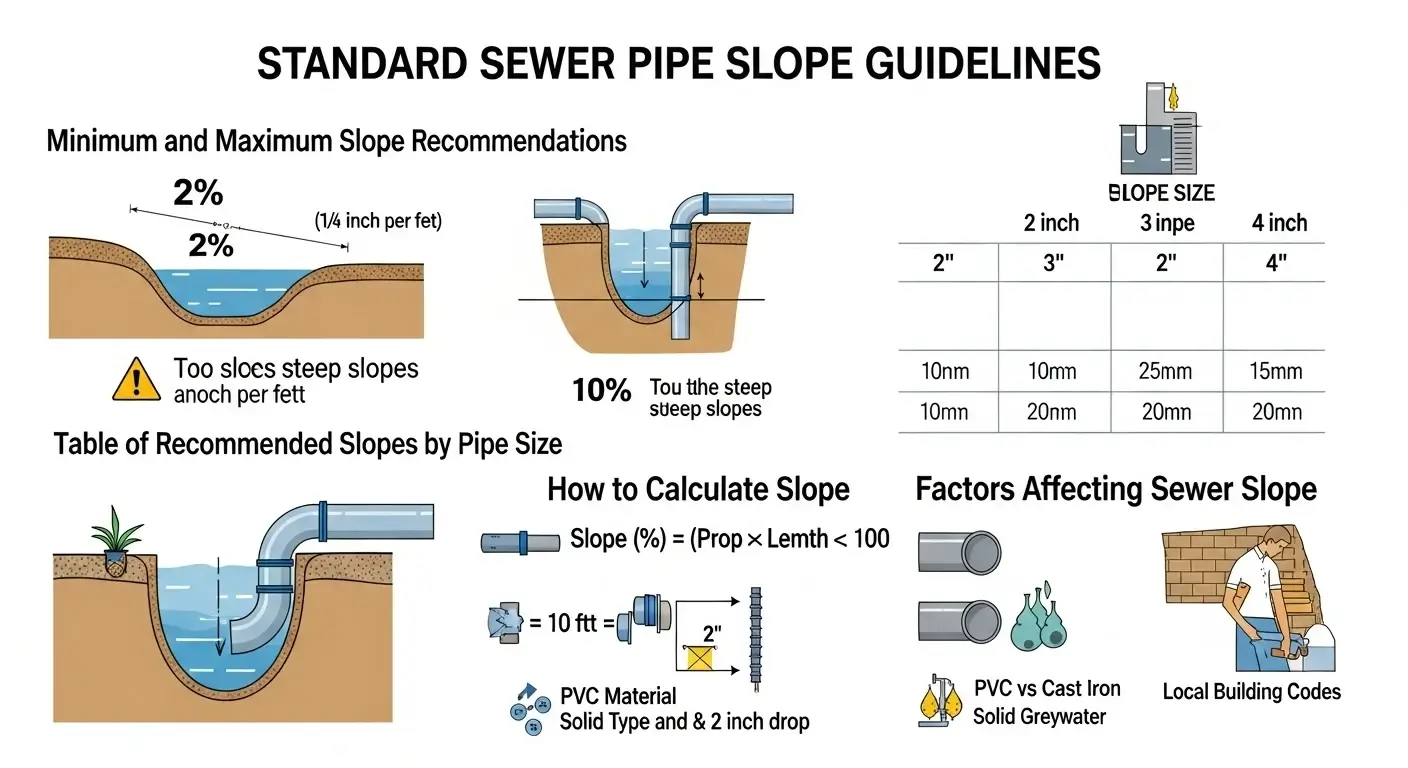Drain Pipe Slope Calculator
Calculate perfect pipe slopes with precision engineering standards
Configuration
Measurements
Calculation Results
Slope Visualization
Sewer Pipe Slope Calculator: How to Determine the Correct Slope
Proper sewer pipe slope is crucial for efficient drainage, preventing clogs, and avoiding costly plumbing issues. At 907 Heating and Plumbing, we specialize in plumbing solutions, ensuring your sewer lines are installed with the correct gradient. This guide explains how to calculate sewer pipe slope, industry standards, and common mistakes to avoid.
📌 Why Sewer Pipe Slope Matters
A correct slope ensures:
- Smooth wastewater flow – Prevents stagnation and blockages.
- Self-cleaning action – Solids are carried away efficiently.
- Compliance with codes – Meets IPC, UPC, and local plumbing standards.
An incorrect slope can lead to:
- Frequent clogs and backups
- Foul odors from stagnant water
- Pipe corrosion and premature damage
📏 Standard Sewer Pipe Slope Guidelines

Most plumbing codes recommend:
- Minimum Slope: 2% (1/4 inch per foot) for 4-inch pipes.
- Maximum Slope: 10% (1-1/4 inch per foot) – Too steep can leave solids behind.
Recommended Slopes by Pipe Size
| Pipe Diameter | Minimum Slope (Per Foot) |
|---|---|
| 2-inch pipe | 1/4 inch (2%) |
| 3-inch pipe | 1/8 inch (1%) |
| 4-inch pipe | 1/4 inch (2%) |
Note: Local codes may vary—always check regulations in your area.
🧮 How to Calculate Sewer Pipe Slope
Use this simple formula:
Slope (%) = (Drop ÷ Length) × 100
Step-by-Step Calculation
- Measure the pipe length (e.g., 10 feet).
- Determine the required drop (e.g., 2 inches for a 4-inch pipe).
- Apply the formula:
Slope = (2 ÷ 120) × 100 = 1.67% (since 10 feet = 120 inches).
Example:
For a 20-foot sewer line, a 4-inch drop is needed for a 2% slope.
⚖️ Factors Affecting Sewer Pipe Slope
- Pipe Material – PVC requires less slope than cast iron.
- Waste Type – Solid waste needs a steeper slope than greywater.
- Local Building Codes – Some areas mandate specific gradients.
⚠️ Common Sewer Pipe Slope Mistakes
Too Flat (<1%)
Causes slow drainage and clogs.
Too Steep (>10%)
Liquids flow too fast, leaving solids behind.
Uneven Slope
Leads to pooling and blockages.
❓ FAQs on Sewer Pipe Slope Calculation
1. What is the minimum slope for a sewer line?
Most codes require 2% slope (1/4 inch per foot) for 4-inch pipes. Smaller pipes may need a steeper slope.
2. Can a sewer pipe be too steep?
Yes. If the slope exceeds 10%, water flows too quickly, leaving waste behind.
3. How do I measure slope without a level?
Use a string and measuring tape:
- Tie a string at the pipe's start and end.
- Measure the drop relative to the length.
4. Does pipe material affect slope requirements?
Yes. Smooth pipes (PVC) need less slope than rough ones (cast iron).
Need Professional Help? Trust 907 Heating & Plumbing
Calculating sewer pipe slope can be tricky. If you're unsure, our licensed plumbers ensure:
- Accurate slope calculations
- Code-compliant installations
- Long-lasting drainage solutions
